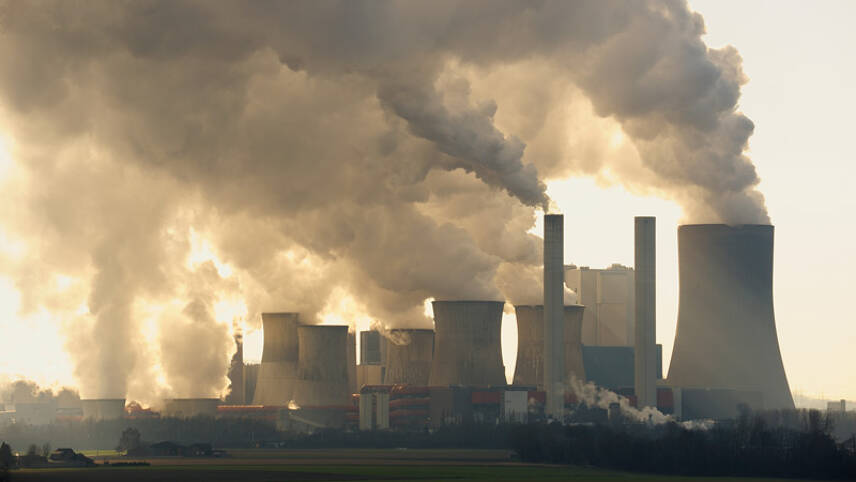Register for free and continue reading
Join our growing army of changemakers and get unlimited access to our premium content

Pictured: Coal-fired power generation in North Rhine-Westphalia, Germany
Emissions Trading Scheme
After lengthy negotiations that seemed stuck at a crossroads this time last week, negotiators struck an agreement on reforms to the EU’s Emissions Trading Scheme (ETS) on Sunday (18 December). The ETS is the second-largest in the world, behind only China, covering more than 10,000 factories, refineries and power plants.
Under the ETS, facilities and companies conducting emission-intensive activities are set a cap on their emissions. Within this budget, organisations can trade allowances. Participants include electricity generators, cement manufacturers, steelworks, oil refineries and airlines.
Reforming the ETS was regarded as necessary in light of the EU strengthening its climate target, aiming now for a 55% reduction in annual emissions by 2030 on the road to carbon neutrality by 2050.
The deal on reform struck this week will see the scheme extending to cover more economic sectors. Negotiators agreed, for example, to create a separate emissions trading market for buildings and transport, which will launch in 2027. This is being dubbed ‘ETS2’.
Also agreed upon were measures to tighten requirements in the coming years, incentivizing heavy industrial players to invest in low-carbon technologies and processes. Sectors covered by the ETS will have to cut their emissions 62% below 2005 levels by 2030 – a significant increase on the current 43% target. Free allowances will be halved by 2030 and then phased out entirely by 2034.
Click here for Euractiv’s full analysis of the agreement, including details on why WWF believes it may be “too little, too late”.
Carbon tax on heating and transport
Carbon pricing is always regarded as a thorny issue. While many businesses are voluntarily applying a carbon price to help align decision-making with climate goals, taxing citizens for purchases such as red meat and road fuel is a different ball game. One needs only to reflect on the Gilet Jaunes movement in France to imagine the potential backlash of a poorly-designed scheme.
As part of the ETS reforms, EU negotiators have provisionally agreed to set a carbon price on emissions arising from the use of fossil fuels for road transport, industrial process heating and building heating from 2027. A delay of one year will be called in if the energy price crisis continues. Domestic and commercial buildings are covered, with the EU hoping to push owners and occupiers to transition away from gas, heating oil and coal systems.
To help support low-income homes in paying the tax, the EU will use proceeds from the ETS2 to create a new €87bn ‘Social Climate Fund’. It has also set a ceiling carbon price of €45 per tonne. At this level, motorists can expect the tax to put 10.5 cents on a litre of petrol and 12 cents on a litre of diesel.
A vote will need to be held on the agreement in early 2023.
Carbon border adjustment mechanism
The ETS changes will be implemented alongside the introduction of a landmark levy on carbon-intensive imported goods. The EU’s carbon border adjustment mechanism (CBAM) is the first of its kind in the world.
Under the CBAM, importers will be asked to pay the EU’s own domestic carbon price on goods including steel, cement, aluminium, fertilisers and electricity and hydrogen. This requirement will be imposed from 1 October 2023 on a trial basis, ahead of the introduction of a permanent levy.
Any companies importing these into the EU will have to buy certificates to cover the carbon emissions embedded in them unless they can prove they have already been accounted for by climate legislation in the producer country.
Over time, the levy will replace ETS free allowances.
While the move is clearly a way to prevent EU manufacturers from being undercut on price by high-carbon imports, some policymakers and observers are concerned whether it will harm the competitiveness of EU exports. Other nations may continue to make cheap, high-emission goods domestically and stop importing alternatives from the EU if they are more costly, is the argument here.
The UK Government this week faced calls to clear up its own proposals for low-carbon product standards from influential business coalition the Aldersgate Group.
‘Watered down’ methane goals
Methane has been something of a hot topic this year. The US and EU, which jointly launched a new ‘Global Methane Pledge’ last year, confirmed at COP27 that more than 250 countries have signed up. The Pledge entails reducing methane emissions by at least 30% this decade.
Some environmental groups are concerned that the Pledge is not implementing strong enough requirements to cut methane from sectors other than fossil fuels, such as agriculture. The Changing Markets Foundation claims that the EU should place less focus on solutions such as feed additives and move more rapidly to cut meat and dairy production.
Now, another concern has emerged. EU energy ministers agreed on new requirements for oil and gas firms to cut methane this week, which have been swiftly criticised as unambitious. These claims are being voiced not only by environmental NGOs but by the European Commission’s own energy chief Kadri Simson.
The ministers are proposing that businesses should report and verify all methane emissions every year and that inspections should be carried out every six months for pipe infrastructure. Critics wanted inspections to be carried out quarterly. They also wanted the requirements to apply to offshore wells deeper than 700 meters, including inactive wells, plus inspection requirements weekly for flare stacks. Instead, monthly inspections for flare stacks have been proposed.
The regulation will also require methane emissions from EU energy imports to be tracked. Given that the EU imports 97% of its oil and 90% of its natural gas, this is significant.


Please login or Register to leave a comment.